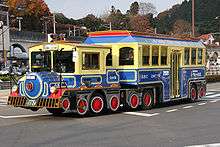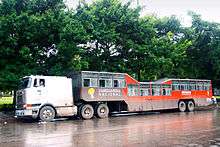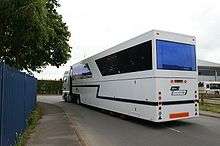Trailer bus
A trailer bus or articulated trailer bus is a bus formed out of a bus bodied semi-trailer pulled by a conventional tractor unit in the same way as a conventional articulated semi-trailer truck.



Trailer buses are usually pulled by a conventional truck from various truck manufacturers, while others have larger space cabs. Trailer bus bodies are built by various local builders.
History
An early trailer bus was designed in Amsterdam in the 1920s as bus designs got longer. As a solution to possible grounding hazards on humped bridges, three prototypes were built in 1924, but proved to be problematic, and later converted to rigid bodies in 1927.[1]
During World War II and in the immediate post-war years, trailer buses were turned to as a simple and economical way of providing bus transport to replace worn out conventional bus fleets. The semi-trailers were basic and uncomfortable, but each could carry more passengers than an ordinary single-decker bus, and nearly as many as a double-decker bus. Indeed, in India, BEST of Mumbai and BMTC of Bangalore had double-decker trailer buses in its fleet during the 1970s and 1980s.[2]
In Australia, 123 semi-trailer type buses were built between 1939 and 1984; one example, a 1947 semi-trailer coupled with an American-built 1943 White M3A1 tractor, is now located in Sydney Bus Museum in Sydney, New South Wales. The Sydney exhibit was the last trailer bus used in NSW, withdrawn in 1977.[3][4]
Trailer buses were also used in Perth, Western Australia, from 1952 onwards, purchased by Western Australian Government Railways, with the trailer bodies built by Scarborough Bus Services.[5]
In 1948, ten British-built[6] trailer buses saw service as a staff canteens for London Transport (in country green livery)[7] with one passing to the Cobham Bus Museum in 1972.
A large order for 1175 buses from the Dutch Railways for buses from Crossley included an order for 250 trailer buses, each to carry 52 seated and 28 standing passengers.[8] The tractor units were delivered as short Crossley DD42s, and these were matched in the Netherlands with DAF built trailer chassis fitted with bus bodies.
In the late 1980s, a Mexican-built trailer bus was in test service in the Los Angeles / Orange County area of California. In the 1990s, Orange County Transportation Authority used it on two express routes. The trailer buses were known as Superbuses.[9]
Custom motor/trailer units manufactured by Orion Bus Industries were used from 1985 to 2012 on the Niagara Parks Commission People Mover route in Niagara Falls, Ontario.
In Greece trailer buses are still, often used for tours, usually in small villages. Trailer Buses are also used in some kids' attractions.
Obsolescence

As early as the mid-1940s, trailer buses began to quickly fall out of favour for a variety of factors:[10]
- The length of trailer buses make them difficult to negotiate sharp turns at narrow street corners;
- Each trailer bus normally requires a two-person crew, with the driver in the tractor and the conductor in the semi-trailer;
- The perceived danger of a passenger-laden semi-trailer dislodging from its tractor while under way has led to many jurisdictions in the United States, Canada and Australia restricting or prohibiting trailer buses.
Trailer buses saw service until at least 1984 in South Africa,[11] possibly due to the rugged terrain in its remote areas, and the availability of specialist bus builders as opposed to truck dealers and basic body builders.
Trailer buses are still in service in Cuba, where they were introduced under the nickname of "camellos" ("camels", from the twin-humped shape of the trailers) during the so-called "Special Period" after the fall of the Soviet Union. As of 2008, the trailer buses are reportedly being gradually retired from service in Havana city, replaced by Chinese-made buses.[12]
Nonetheless, the Munich transit authority ordered a batch of trailer buses from Solaris with deliveries starting in 2013. The buses were intended for service on the city's busiest routes. The advantages of such buses were the ability to attach or detach the trailer depending on demand, spaciousness and flexibility.[13]
See also
References
- An early articulated bus from Amsterdam Archived 2008-03-02 at the Wayback Machine
- Ayyar, Kamakshi (July 15, 2016). "Vintage Photos: Time-Travelling With Mumbai's Iconic BEST Buses". National Geographic Traveller India.
- Sydney Bus Museum Trailer bus exhibit
- Fotopic image of a White powered trailer bus in Sydney Bus Museum, NSW
- Perth semi-trailer buses A Fotopic gallery of various trailer buses in Perth
- Cobham Bus Museum Archived 2008-07-05 at the Wayback Machine Trailer Bus exhibit details
- CCMV - Classic Commercial Motor Vehicles A fotopic image of the London transport staff canteen trailer bus
- www.crossley-motors.org.uk The Crossley Dutch buses
- http://www.subchat.com/buschat/readflat.asp?Id=80766
- Dirk HR Spennemann, Buses Up & Down the Murray: The Murray Valley Coach Company of Albury, {retro|spect}, Albury, NSW, 2006, ISBN 978-1-921220-03-6, pp.78-9.
- www.sa-transport.co.za Image of trailer buses at a terminus in Umtata in 1984
- Weissert, Will (19 April 2008). "Changing Cuba: Monster buses vanish from Havana streets". The Associated Press (reprinted in The Guardian). Retrieved 28 May 2008.
- Canters, Raf (1 August 2014). "Munich orders buses with trailers for passenger transport (Germany)". eltis.org. Retrieved 24 September 2017.
External links
| Wikimedia Commons has media related to Bus trailers. |
- Fotopic image, an illustration of the Crossley Dutch trailer bus "LIJNBUS 1947 trailer type Crossley DAF, NZHVM
- Images of trailer buses in South Africa
- Images of trailer buses in South Africa
- Α trailer bus that was used in Greece
- Another Trailer bus that was used in Greece
- Another Trailer bus that was used in Greece
_Arriva_London_New_Routemaster_(19522859218).jpg)